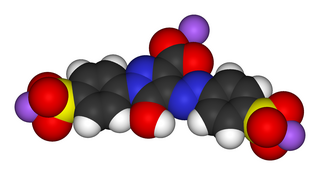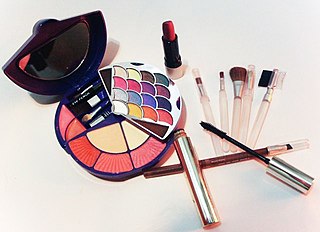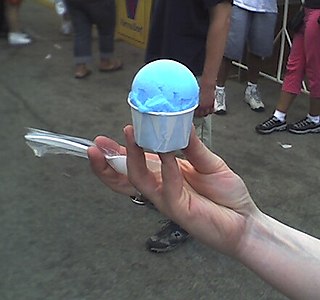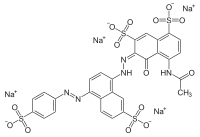
Food additives are substances added to food to preserve flavor or enhance taste, appearance, or other sensory qualities. Some additives have been used for centuries as part of an effort to preserve food, for example vinegar (pickling), salt (salting), smoke (smoking), sugar (crystallization), etc. This allows for longer-lasting foods such as bacon, sweets or wines. With the advent of ultra-processed foods in the second half of the twentieth century, many additives have been introduced, of both natural and artificial origin. Food additives also include substances that may be introduced to food indirectly in the manufacturing process, through packaging, or during storage or transport.

Food coloring, color additive or colorant is any dye, pigment, or substance that imparts color when it is added to food or beverages. Colorants can be supplied as liquids, powders, gels, or pastes. Food coloring is commonly used in commercial products and in domestic cooking.
Carmine – also called cochineal, cochineal extract, crimson lake, or carmine lake – is a pigment of a bright-red color obtained from the aluminium complex derived from carminic acid. Specific code names for the pigment include natural red 4, C.I. 75470, or E120. Carmine is also a general term for a particularly deep-red color.

Tartrazine is a synthetic lemon yellow azo dye primarily used as a food coloring. It is also known as E number E102, C.I. 19140, FD&C Yellow 5, Yellow 5 Lake, Acid Yellow 23, Food Yellow 4, and trisodium 1-(4-sulfonatophenyl)-4-(4-sulfonatophenylazo)-5-pyrazolone-3-carboxylate.

Yellow 2G is a food coloring denoted by E number E107 with the color index CI18965. It has the appearance of a yellow powder, and it is soluble in water. It is a synthetic yellow azo dye.

Sunset yellow FCF is a petroleum-derived orange azo dye with a pH-dependent maximum absorption at about 480 nm at pH 1 and 443 nm at pH 13, with a shoulder at 500 nm. When added to foods sold in the United States, it is known as FD&C Yellow 6; when sold in Europe, it is denoted by E Number E110.
Brominated vegetable oil (BVO) is a complex mixture of plant-derived triglycerides that have been modified by atoms of the element bromine bonded to the fat molecules. Brominated vegetable oil has been used to help emulsify citrus-flavored beverages, especially soft drinks, preventing them from separating during distribution. Brominated vegetable oil has been used by the soft drink industry since 1931, generally at a level of about 8 ppm. Several countries have banned use of BVO in food and drink products because of the potential for adverse health effects in humans.

An acid dye is a dye that is typically applied to a textile at low pH. They are mainly used to dye wool, not cotton fabrics. Some acid dyes are used as food colorants, and some can also be used to stain organelles in the medical field.

Brilliant blue FCF is a synthetic organic compound used primarily as a blue colorant for processed foods, medications, dietary supplements, and cosmetics. It is classified as a triarylmethane dye and is known under various names, such as FD&C Blue No. 1 or acid blue 9. It is denoted by E number E133 and has a color index of 42090. It has the appearance of a blue powder and is soluble in water and glycerol, with a maximum absorption at about 628 nanometers. It is one of the oldest FDA-approved color additives and is generally considered nontoxic and safe.

Erythrosine, also known as Red No. 3, is an organoiodine compound, specifically a derivative of fluorone. It is a pink dye which is primarily used for food coloring. It is the disodium salt of 2,4,5,7-tetraiodofluorescein. Its maximum absorbance is at 530 nm in an aqueous solution, and it is subject to photodegradation.

Ponceau 4R is a synthetic colourant that may be used as a food colouring. It is denoted by E Number E124. Its chemical name is 1-(4-sulfo-1-napthylazo)-2-napthol-6,8-disulfonic acid, trisodium salt. Ponceau is the generic name for a family of azo dyes.

Allura Red AC, also known as FD&C Red 40 or E129, is a red azo dye commonly used in food. It was developed in 1971 by the Allied Chemical Corporation, who gave the substance its name.

Fast Green FCF, also called Food green 3, FD&C Green No. 3, Green 1724, Solid Green FCF, and C.I. 42053, is a turquoise triarylmethane food dye. Its E number is E143.

Amaranth, FD&C Red No. 2, E123, C.I. Food Red 9, Acid Red 27, Azorubin S, or C.I. 16185 is a modified red azo dye used as a food dye and to color cosmetics. The name was taken from amaranth grain, a plant distinguished by its red color and edible protein-rich seeds.

Red 2G is a synthetic red azo dye. It is soluble in water and slightly soluble in glycerol. It usually comes as a disodium salt of 8-acetamido-1-hydroxy-2-phenylazonaphthalene-3,6 disulfonate.

Brown FK, also called Kipper Brown, Chocolate Brown FK, and C.I. Food Brown 1, is a brown mixture of six synthetic azo dyes, with addition of sodium chloride, and/or sodium sulfate. It is very soluble in water. When used as a food dye, its E number is E154.

Brown HT, also called Chocolate Brown HT, Food Brown 3, and C.I. 20285, is a brown synthetic coal tar diazo dye.

Cosmetics ingredients come from a variety of sources but, unlike the ingredients of food, are often not considered by most consumers. Cosmetics often use vibrant colors that are derived from a wide variety of sources, ranging from crushed insects to rust.

Blue raspberry is a manufactured flavoring and food coloring for candy, snack foods, syrups, and soft drinks. The color does not derive from any species of raspberry; however, the flavor is intended to mimic that of a blackcap raspberry. Its flavor was developed using esters that are part of the flavor profile of pineapple, banana and cherry. Sugar is commonly added to create taste appeal for the blue raspberry flavoring.
The Food Chemicals Codex (FCC) is a collection of internationally recognized standards for the purity and identity of food ingredients.

















